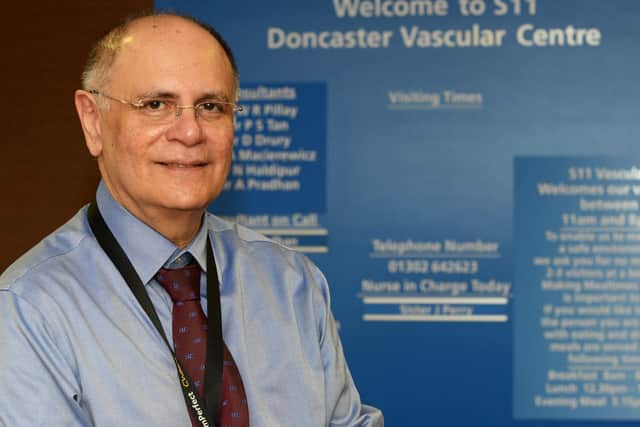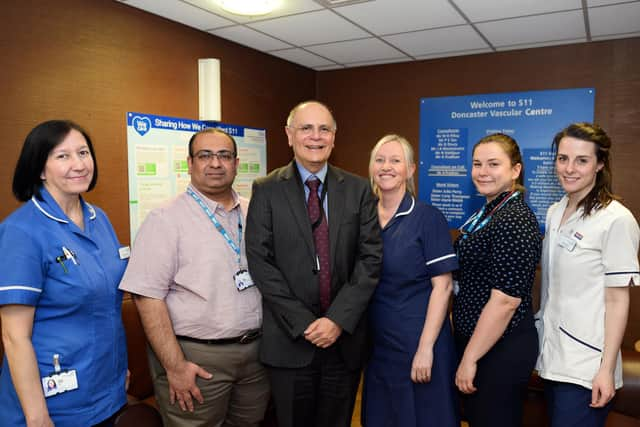Doncaster Royal Infirmary will get new building and more regional importance, retiring boss predicts
and live on Freeview channel 276
Back in 1983, he was only there on a temporary basis, still based in Sheffield. But this month, he is leaving after working his way up to medical director – and he believes he is bowing out with a new hospital on the horizon.
In January, he was among those meeting health secretary Matt Hancock to tell him why Doncaster needed a new hospital.
Advertisement
Hide AdAdvertisement
Hide AdNow as he retires this month, he feels more confident than at any time in those 37 years that something is going to happen.


He said: “It may be politically sensitive, but I think the Doncaster Royal Infirmary is going to become a much more important hospital for delivery of 24/7 emergency services. I see two hospitals doing most of it regionally, the Northern General in Sheffield and the DRI, and for us the biggest issue has been infrastructure not supporting modern day health care.
“We need a new hospital and have needed it for some time, and I think it’s the next big thing that’s going to happen in Doncaster.
“The biggest problem in the NHS is staffing and having the number of doctors and nurses and allied health professionals, and a new hospital would do two things. It would allow us to use our staff more flexibly and efficiently; and it would also help us attract staff to come and work in Doncaster. It’s a double bonus.
Advertisement
Hide AdAdvertisement
Hide Ad“I’m optimistic the new hospital will happen. You have to seize opportunities and I think this period in time is unique. We have been lobbying not just the NHS, but the government too, for what we see as necessary investment for the future. We’re currently having to deliver 21st century medicine in a building that dates back to the 1930s. I’m very hopeful, and I think we will see it opening in the next seven or eight years, with work starting in four or five.”


When he first worked at the DRI in 1983, Mr Singh’s first impression was a place with friendly staff, and that it was easy to park. Parking is now regarded as a problem.
After initially qualifying as a doctor he worked in every hospital in South Yorkshire at some point, training as a surgeon in Sheffield, and then returning to Doncaster in 1991 as a registrar, meeting his wife, also a doctor, while working in the borough. She is now a GP in Bentley.
In 1996 he became a consultant surgeon at the DRI, specialising in vascular surgery, and setting up a programme of operations to prevent strokes. He also had a major role training surgeons regionally.
He was appointed as medical director at the DRI in 2012.
Advertisement
Hide AdAdvertisement
Hide AdOver that period, one of the achievements Mr Singh is most proud of is improving the mortality rates at the hospital, and after his appointment, he promised to re-organise emergency care at the DRI.
At that time, it was unusual for consultants to work at weekends. He changed that.
“I spent the first two years changing the way consultants worked, to increase the number of consultants working at the weekends by four fold. It made a huge difference. Risk adjusted mortality rates when I came into post suggested we had more deaths than would be expected. Today we have less than expected across the board.”
Another source of great pride is the Doncaster and Bassetlaw Teaching Hospitals Trust’s recent regrading as ‘good’. It had been rated as requiring improvement since 2015.
“The good rating is my final objective delivered,” he said.
Advertisement
Hide AdAdvertisement
Hide AdAmong the biggest challenges over the last eight years have been dealing with the weather and winter flu outbreaks, and the impact those can have on the number of clinical staff available to deal with patients.
“We have had bad bouts of flu, but when that has happened, everyone has chipped in.
“We have not had any cases of coronavirus yet, but we have had flu across most of the winter. The problem is that staff catch it and you can have difficulties staffing the wards, coupled with a lot of emergency admissions. November was bad for flu last year, and this year we have seen a six to seven per cent increase in emergency admissions. It gets harder every year because of the rising pressure on A&E.
“In terms of coronavirus, we are taking measures, complying with national guidelines.
Advertisement
Hide AdAdvertisement
Hide Ad“Bad snow has also created problems, when staff have not been able to get in. When that happened, we had people who walked in for six or seven miles.”
Mr Singh is grateful to many people and organisations for their help over the last eight years – but was keen to express his gratitute to the Doncaster Cancer Detection Trust and the people of Doncaster for their generosity over the years in helping the DRI get hold of state of the art equipment to enable earlier diagnosis and better treatment for a variety of conditions.
He said: “When I first came to the Infirmary, we were short of x-ray equipment to allow us to visualise the circulation in patients. We initiated the Dreamheart Appeal and the Free Press supported this charity which raised funds to enable us to purchase the x-ray equipment we needed.”